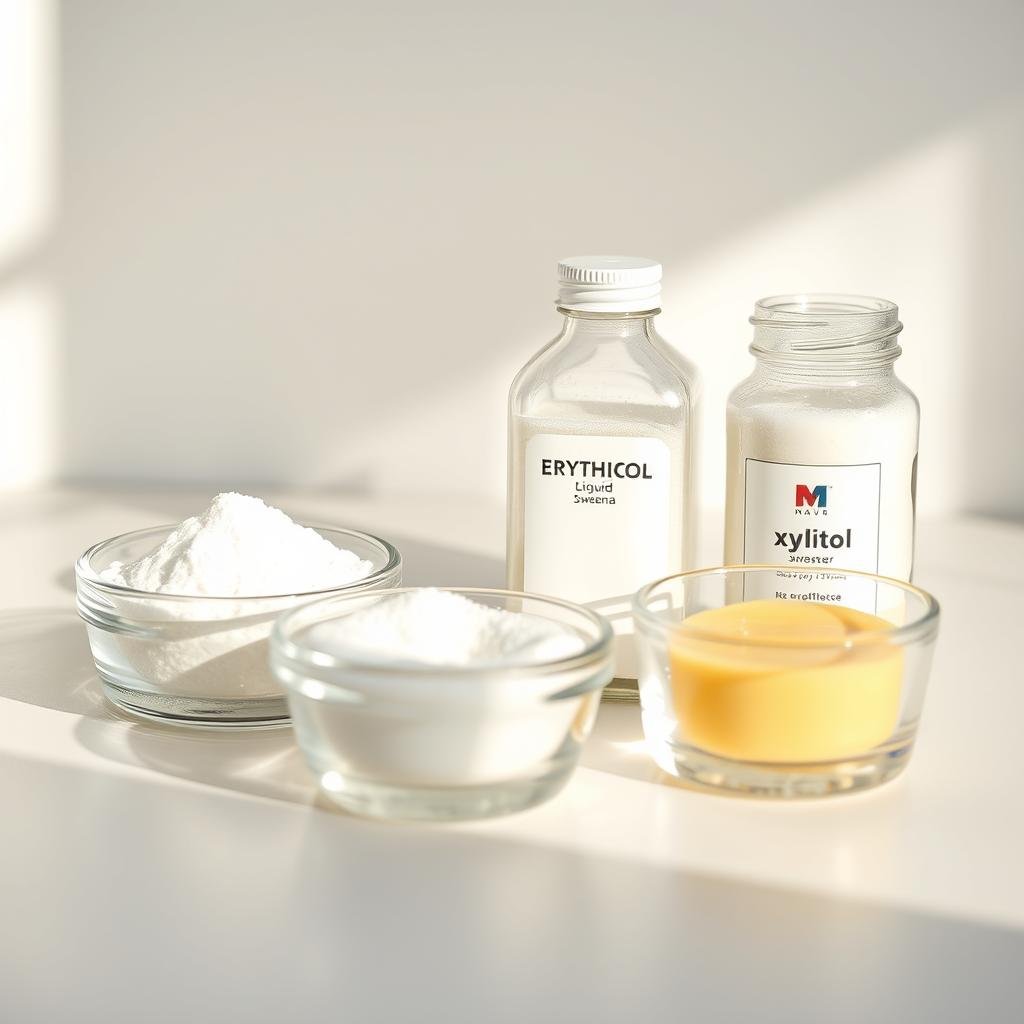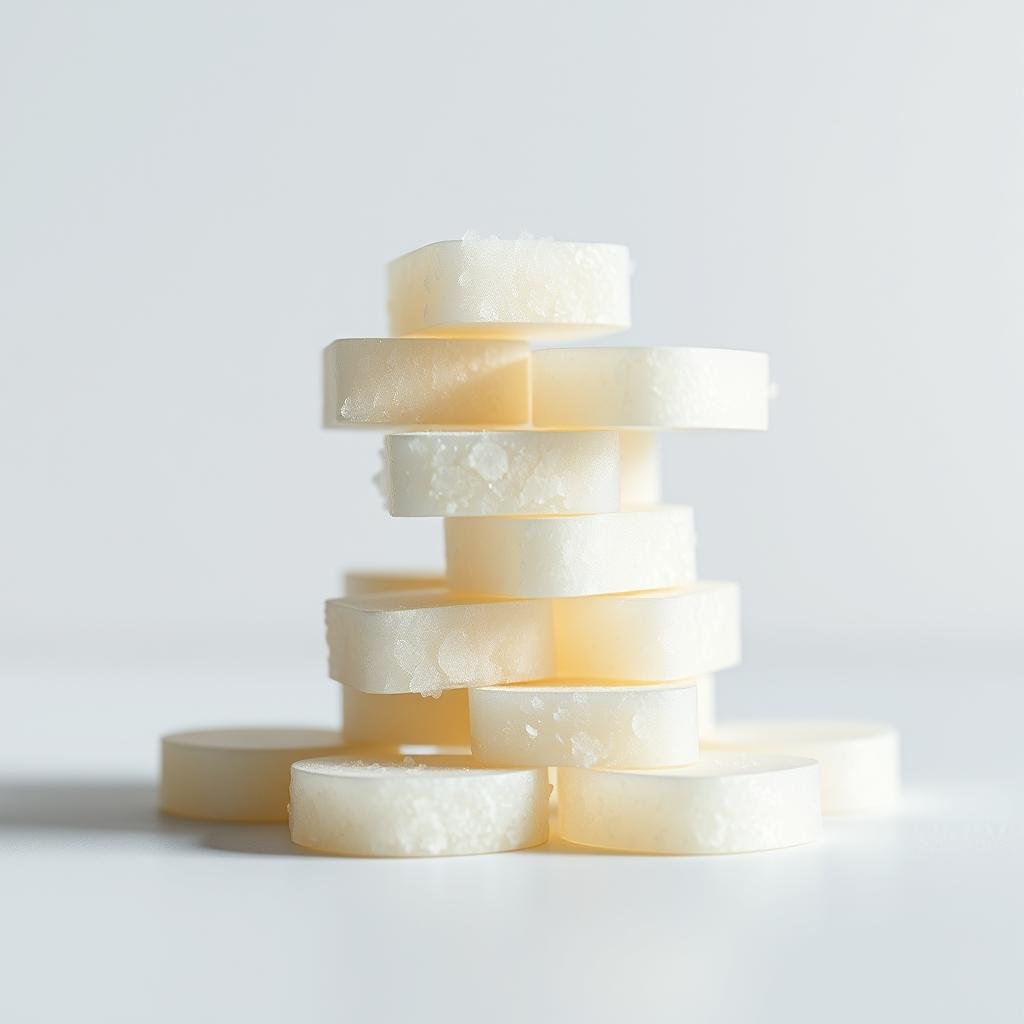Did you know that on a typical ketogenic plan, you limit carbs to about 20–50 grams per day? A single tablespoon of regular sugar can knock you out of ketosis for hours. That’s why picking the right sweeteners is so important.
Craving sweetness while staying in ketosis can feel impossible. But, the good news is that you don’t have to give up flavor to protect your health. The right Keto-Friendly Sweeteners That Keep Insulin Stable let you enjoy desserts, coffee, and even baked goods.
These options won’t risk blood sugar spikes or kick you out of fat-burning mode. In this guide, we’ll explore 7 amazing options. They not only taste great but also support steady energy, reduced cravings, and long-term success on your low-carb lifestyle.
The best Keto-Friendly Sweeteners That Keep Insulin Stable include stevia, erythritol, monk fruit, allulose, xylitol, yacon syrup, and low-carb blends. These options provide sweetness without spiking blood sugar or disrupting ketosis.
Key Takeaways
- Limiting carbs to 20–50 g/day makes the right sweetener essential for maintaining ketosis.
- Choose insulin-friendly keto sweeteners with low or zero glycemic impact to avoid insulin spikes.
- Best keto sweeteners include stevia, erythritol, monk fruit, and allulose, each with distinct uses.
- Watch ingredient labels for hidden sugars and fillers that can raise blood glucose.
- Blending sweeteners often improves taste and texture while minimizing aftertaste and digestive issues.
Why sweeteners matter on Keto: insulin, ketosis, and cravings
You want sweets while staying in ketosis. Choosing the right sweetener affects your hormones, hunger, and energy. That is why sweeteners matter on keto and why a few smart swaps keep your plan on track.
How sweeteners can affect your insulin and ketone production
Taste receptors in your mouth and gut can trigger hormone release when you consume sweet flavors. Studies in journals like Nutrients show some non-nutritive sweeteners can also stimulate hormone release. This may prompt insulin release in certain people, which can lower ketone production.
The role of insulin in fat storage and ketosis is central. When insulin rises, your body favors glucose uptake and fat storage. Small insulin excursions can blunt ketogenesis, so you want minimal spikes to protect ketone output.
Why most sweeteners spike insulin and can break ketosis
Many caloric sweeteners deliver carbohydrates that raise blood glucose and trigger insulin. Table sugar, honey, maple syrup, agave, dates, maltodextrin, and dextrose are common offenders. Their glycemic load makes it easy to exit ketosis after a serving.
Even some sugar substitutes are sold in blends with dextrose or maltodextrin. Those additives defeat ketogenic goals by producing measurable insulin responses. Read labels to avoid hidden carbs that undermine progress.
Impact of blood sugar swings on appetite, energy, and fat storage
Blood sugar friendly sweeteners help keep glucose steady. When you avoid big swings, you usually feel less hungry between meals and maintain more consistent energy for workouts and daily tasks.
Frequent spikes followed by drops increase cravings and favor fat storage through repeated insulin rises. Choosing non-impact sweeteners for ketosis reduces that risk and supports steady appetite control.
| Sweetener Type | Typical Insulin Effect | Ketosis Risk | Notes for Use |
|---|---|---|---|
| Table sugar / honey / maple | High | High — likely to break ketosis | Use only if refeeding; avoid during strict keto |
| Maltodextrin / dextrose blends | High | High — hidden carbs can sabotage results | Check ingredient lists on packets and mixes |
| Stevia, monk fruit, erythritol, allulose | Minimal to none in most studies | Low — generally safe for maintaining ketosis | Prefer pure forms or tested blends marketed as blood sugar friendly sweeteners |
| Maltitol, sorbitol | Moderate | Moderate — may raise glucose in some people | Use with caution; can cause GI symptoms |
| Yacon syrup, some fruit syrups | Variable | Medium — prebiotic benefits but not always keto-safe | Limit for cooking; monitor blood glucose |
Keto-Friendly Sweeteners That Keep Insulin Stable
You want sweet treats without a blood sugar spike. Keto-Friendly Sweeteners That Keep Insulin Stable let you enjoy treats while protecting ketosis. This guide explains what “insulin-friendly” means and how low-glycemic sweeteners and non-impact sweeteners for ketosis work. It also looks at evidence for stevia, erythritol, monk fruit, and allulose.

Definition and importance of insulin-friendly sweeteners
An insulin-friendly sweetener causes little to no rise in blood glucose or insulin after you consume it. These sweeteners are often non-nutritive, such as stevia and monk fruit, or poorly absorbed, like erythritol and allulose. Choosing these options reduces the chance of an insulin surge that can interrupt fat burning and derail ketosis.
How low-glycemic sweeteners and non-impact sweeteners for ketosis preserve metabolic balance
Low-glycemic sweeteners avoid the carbohydrate load that triggers insulin release. Non-impact sweeteners for ketosis tend to have a glycemic index of zero or near zero. This means your pancreas sees little stimulus to secrete insulin. It helps keep ketone production steady and lessens blood sugar swings that drive cravings and energy dips.
Evidence summary: stevia, erythritol, monk fruit, allulose and their glycemic indices
Stevia (steviol glycosides) offers virtually zero calories and carbs. Clinical trials, including work by Anton and colleagues, report minimal effect on postprandial glucose and insulin. This gives stevia an effective GI near zero.
Erythritol is a sugar alcohol with GI = 0. It is mostly absorbed in the small intestine and excreted unchanged in urine. Studies show minimal insulin response and some evidence that erythritol may slow carbohydrate absorption through α-glucosidase inhibition.
Monk fruit supplies sweetness via mogrosides. The extract has zero calories and no glycemic effect. The FDA lists high-purity monk fruit extracts as GRAS, which supports its use when you need sweetness without carbs.
Allulose behaves like sugar in recipes but is poorly metabolized and produces a negligible glycemic response. Research reports a GI of zero in practical analyses. This makes it useful when you want sugar-like texture and browning without raising insulin.
| Sweetener | Type | Glycemic Index | Insulin Impact | Notes |
|---|---|---|---|---|
| Stevia (steviol glycosides) | Non-nutritive plant extract | ~0 | Minimal to none | Zero calories, may be bitter alone; blends improve flavor |
| Erythritol | Sugar alcohol (polyol) | 0 | Minimal | Well tolerated by most; some have digestive sensitivity |
| Monk fruit (mogrosides) | Non-nutritive fruit extract | 0 | None reported | Often blended for bulk; check labels for added sugars |
| Allulose | Rare sugar (poorly metabolized) | 0 | Negligible | Mimics sugar in baking; check tolerance for GI effects |
How to choose keto-approved sweeteners: criteria and label warnings
Choosing the right sweetener is key to staying in ketosis and feeling good. Here are some clear guidelines to help you pick the best sugar substitutes for keto.
Criteria for keto-approved sweeteners
- Glycemic impact: Look for sweeteners with a glycemic index of zero or very low. This keeps blood sugar and insulin steady.
- Calories and carbs: Choose low-to-zero calorie options that don’t add net carbs to your daily allowance.
- Digestion and tolerance: Some polyols can cause gas, bloating, or diarrhea. Erythritol and allulose are often easier to digest than maltitol or sorbitol.
- Heat stability and cooking use: If you bake, pick sweeteners that hold up in the oven and provide texture. Allulose and erythritol blends often brown and caramelize better than pure stevia.
Watch for hidden sugars on labels and additives
Always read ingredient lists. Products labeled “natural” can hide carbs like maltodextrin, dextrose, sucrose, cane sugar, or coconut sugar. Monk fruit and stevia packets often include bulking agents like dextrose or maltodextrin. Maltodextrin has a carb load similar to table sugar and should be avoided for keto.
Practical label checks
- Scan for maltodextrin, dextrose, sucrose, and cane sugar.
- Note words like “sugar blends” or “natural flavor” that may hide carbs.
- Check net carbs per serving and the serving size; small packets can mislead you.
Considerations for your gut, pets, and cooking needs
Think about how a sweetener affects digestion. Erythritol and allulose usually cause fewer GI issues than maltitol or sorbitol. Tolerance varies, so test small amounts first.
Xylitol tastes like sugar but is deadly to dogs. Store xylitol-containing products out of reach and warn guests if you have pets.
For cooking, match the sweetener to the recipe. Sucralose is heat-stable, while stevia may need blending for baking volume. Allulose behaves most like sugar for browning and texture. When you need bulk, choose blends formulated for baking or follow recipes developed for your chosen sugar substitutes for keto.
These sweeteners pair perfectly with keto dessert recipes and enhance keto smoothies.
Stevia — natural zero-calorie sweetener (description and uses)
Stevia comes from the leaves of Stevia rebaudiana. Its active steviol glycosides, like rebaudioside A, are 250–300 times sweeter than sugar. It has almost no calories and carbs, so it doesn’t raise blood sugar or insulin much. Many people pick stevia for keto diets because it’s a reliable sweetener.

Steviol glycosides are barely absorbed by the body and don’t turn into glucose. Studies by Anton and Ashwell show stevia doesn’t raise blood sugar or insulin levels. This makes stevia a good choice for managing blood sugar.
Best uses: beverages, baking (with blends), and dose guidance
Stevia is great in coffee, tea, and cold drinks. It adds sweetness to sauces and dressings without calories. For baking, mix stevia with erythritol or allulose to keep things fluffy. Start with small amounts of liquid drops, powdered extracts, or blends to avoid too much sweetness.
Explore easy low-carb coffee hacks that pair perfectly with keto-friendly sweeteners.
Pros and cons: intense sweetness, possible aftertaste, product quality matters
Stevia has no calories, doesn’t raise blood sugar, and is easy to find. It’s good for diabetics and keto diets. But, it’s very sweet and might have a bitter taste for some. Look for pure stevia extracts or trusted brands without added sugar or dextrose.
Stevia is a top choice for keto diets when you need intense sweetness without affecting your metabolism. Mixing it with erythritol or allulose can reduce bitterness and improve texture. If you watch your glucose or ketones, stevia is a good pick for low-carb diets.
Erythritol — sugar alcohol with minimal insulin impact
Erythritol is a good choice if you want sweetness without insulin spikes. It’s mostly not digested and is excreted in urine, giving it almost no calories. It’s also good for those on keto because it doesn’t raise blood sugar or insulin much.

How erythritol is absorbed and why GI = 0 matters for insulin
Erythritol is unique because your body doesn’t break it down much. This is why it has a very low glycemic index. It helps keep ketones up and insulin levels stable, unlike regular sugar.
Best uses: baking, sauces, tabletop; taste profile and cooling effect
Erythritol is great for baking, sauces, and as a sweetener at the table. It’s about 60–80% as sweet as sugar. You can mix it with other sweeteners to get the right sweetness. It also has a cooling effect, which can enhance flavors in recipes.
Side effects and tolerance: digestive issues in some people
Erythritol is usually easier on your stomach than other sugar alcohols. Most people can handle it without problems. But, eating too much might cause gas or diarrhea. Start with small amounts to see how you react.
When picking sweeteners, think about taste, how your body handles them, and their effect on blood sugar. Erythritol is a good choice for keto diets. It’s among the best for keeping blood sugar stable.
Monk Fruit — high-intensity natural sweetener with no carbs
Monk fruit, also called luo han guo, is a sweetener made from mogrosides, not sugars. It’s 100–250 times sweeter than sucrose but has almost no calories or carbs. This makes it a top choice for keeping insulin levels stable.
Mogrosides and how they work
Mogrosides are compounds in plants that activate sweet receptors without raising blood sugar. The body doesn’t break them down into glucose. This is why monk fruit keto products don’t raise blood sugar levels. The FDA has approved monk fruit extract as safe for use as a natural sweetener.
How to use monk fruit in everyday cooking
Monk fruit is great in drinks and sauces because of its strong sweetness. In baking, it’s often mixed with other ingredients to replace sugar’s bulk. Always check the label to avoid added sugars or carbs.
Choosing between cost, taste, and product form
Monk fruit is pricier than stevia or erythritol. It comes in liquid, powder, or blended forms like monk fruit + erythritol. Its taste is mild and similar to sugar, with less bitterness than some stevia products. For baking, choose blends that add volume and texture.
Monk fruit is a great choice for a keto diet that aims for steady blood sugar. Use it with other natural sweeteners to adjust sweetness without raising insulin levels.
Allulose — sugar-like sweetener that behaves neutrally for insulin
Allulose tastes like sugar but doesn’t raise blood sugar levels. It’s great for recipes needing sugar’s texture and color. This makes it a top choice for those on a keto diet.
How allulose is metabolized and its zero glycemic response
Allulose is a rare sugar that your body absorbs but doesn’t use for energy. It mostly goes through your system without affecting your blood sugar. This makes it a good choice for those following a keto diet.
Best uses: baking, sauces, and recipes where sugar-like behavior is desired
Use allulose in baked goods for caramelization and moisture. It browns like regular sugar and adds texture to cookies and sauces. You can replace it 1:1 in many recipes, but you might need to adjust liquid and baking time.
Availability, labeling, and digestive tolerance
Allulose is sold as a standalone product and in blends. Always check labels for added sugars or fillers that could affect carbs. It’s more available in the U.S. than in the EU. Start with small amounts to see how your body reacts.
Here’s a quick guide to help you choose the best sweetener for your needs.
| Feature | Allulose | Erythritol | Stevia |
|---|---|---|---|
| Glycemic/Insulin impact | Near zero; insulin-friendly | GI = 0; minimal effect | No carbs; no effect |
| Culinary behavior | Browns, provides bulk and mouthfeel | Good for bulk; cooling effect | High sweetness; needs bulking agent |
| Best sweeteners for stable blood sugar | Excellent choice for baking and sauces | Great for tabletop and baking blends | Ideal for drinks and low-volume recipes |
| Digestive tolerance | May cause upset at high doses; test slowly | Generally well tolerated; high doses can cause issues | Well tolerated in normal amounts |
| Labeling notes | Watch for blends and added sugars; net carbs vary | Often paired with stevia or monk fruit | Check for dextrose or maltodextrin fillers |
Xylitol, Yacon Syrup, and Smart Blends for Keto
Choosing the right sugar substitutes for keto is key. It helps you stay in ketosis and feel great. Here’s a guide on xylitol, yacon syrup, and blends to help you pick the best for your meals and goals.
Xylitol: pros and precautions
Xylitol tastes and bakes like sugar, making recipes feel familiar. It’s good for your teeth and is found in many sugar-free products.
But, be careful around pets as xylitol is toxic to dogs. Some people might get a bit of stomach upset with too much. Also, it might slightly raise blood sugar levels, so watch your intake if you’re tracking ketones and glucose.
Yacon syrup: prebiotic profile and limits
Yacon syrup comes from a South American root and is full of FOS. These fibers are good for your gut and might help with insulin levels.
But, yacon syrup has carbs and doesn’t do well with heat. It’s best used as a cold syrup or topping. Make sure it fits within your daily carb limit before using it a lot.
Why blends often work better
Blends for keto mix strong sweeteners like stevia or monk fruit with fillers like erythritol. They reduce bad taste, add bulk for baking, and feel like sugar in your mouth.
Popular blends like Truvia mix erythritol with stevia. But, always check the label. Some blends have carbs from dextrose or maltodextrin. Choose blends that are low in carbs and made with clean ingredients.
Do small tests when trying new sweeteners. Everyone’s taste and digestion are different. This way, you can find the best sweeteners for keto without any surprises.
Sweeteners to avoid on Keto: high-glycemic hidden sugars and problematic polyols
Knowing which sweeteners can kick you out of ketosis is key. Some natural sugars and processed additives can raise your blood sugar and insulin levels. This goes against the keto diet’s goals and makes tracking harder.
High-glycemic natural sweeteners to skip
Honey, maple syrup, agave nectar, and dates are full of carbs. They digest fast and cause a big insulin spike. Using them can knock you out of ketosis and undo the fat-adaptation benefits.
Hidden sugar culprits and additives to watch for
Many foods hide sugar in plain sight. Look for maltodextrin, dextrose, sucrose, coconut sugar, and cane sugar on labels. These have similar carb counts to table sugar. Powdered sweetener blends often include dextrose as a filler. Always check the ingredient list to avoid high-glycemic hidden sugars that can raise your blood sugar.
Polyols to avoid or limit
Not all sugar alcohols are good for keto. Maltitol and sorbitol can raise blood glucose and cause digestive issues. Tagatose and some other polyols can add calories or cause tolerance problems. Treat these as sugar substitutes to skip or limit until you know how your body reacts.
Maltodextrin dextrose warning
If a product lists maltodextrin or dextrose, it’s like sugar. They quickly turn to glucose and can spike insulin. Avoid them on strict keto days. Even small amounts can mess with ketone production and slow down fat loss.
| Ingredient | Why to avoid | Typical impact on keto |
|---|---|---|
| Honey / Maple / Agave / Dates | High simple sugar content; rapid absorption | Strong blood glucose rise; likely exit from ketosis |
| Maltodextrin | Highly processed starch that converts to glucose | Quick insulin response; use caution or avoid |
| Dextrose | Food-grade glucose; often used as filler | Raises blood sugar similar to table sugar |
| Sucrose / Cane / Coconut sugar | Sucrose is glucose + fructose; high carb load | Elevates insulin and blood glucose; not keto-friendly |
| Maltitol | Sugar alcohol with higher glycemic effect | May raise glucose and cause GI upset; avoid |
| Sorbitol | Sugar alcohol that can be absorbed and fermented | Possible blood sugar effect and digestive issues; limit |
| Tagatose | Lower GI but caloric and tolerance varies | Use cautiously; monitor effect on ketones |
For the best results, stick to trusted non-impact sweeteners and always read labels. Avoiding high-glycemic hidden sugars and problematic polyols will keep your insulin stable and help you stay on track with your keto goals.
Practical tips for using keto sweeteners and staying in ketosis
Using keto sweeteners can make your recipes reliable and keep your insulin stable. Start by making simple swaps and reading labels. Also, track how your body reacts. Here are steps to adjust recipes, mix products, and check your results.
How to adjust sweetness levels and convert recipes
Stevia is very concentrated. Use the conversion charts from the manufacturer for liquid and powdered forms. Erythritol is about 60–80% as sweet as sugar. You might need to add more or mix it with a sweetener that’s more intense.
Allulose is very close to sugar in taste and browning. You can often use it at a 1:1 ratio.
When adjusting sweetness, test small batches first. Pay attention to texture and browning. Then, scale up the recipe once you’re happy with it.
Combine sweeteners to reduce aftertaste and optimize texture
Mix stevia or monk fruit with erythritol or allulose to reduce bitterness and add bulk. Commercial blends like Truvia and Swerve can save time and give consistent results. For volume, use allulose or add powdered erythritol.
To mix sweeteners for baking, start with a base of erythritol. Add 1–2% stevia or monk fruit by weight. Adjust to taste in later batches.
Serving sizes, digestive tolerance, and tracking
Start with small servings to test your tolerance. Erythritol and allulose might cause fewer GI issues than others. But, everyone reacts differently. Remember, too much can add calories and affect your appetite.
Use tracking ketones and glucose to see how a sweetener affects you. A glucose and ketone meter can show your personal response. Log your results after trying a new sweetener to spot patterns.
Label and product tips
Check ingredient lists for hidden carbs like maltodextrin or dextrose. Choose products labeled for baking if you need stability and volume. If unsure, pick a blend with erythritol or allulose first, and stevia or monk fruit as a small percentage.
Quick checklist
- Use conversion charts for stevia, erythritol, and allulose.
- Adjust sweetness levels gradually and taste as you go.
- Combine sweeteners for better flavor and texture.
- Start small to test digestive tolerance.
- Keep tracking ketones and glucose to confirm insulin stability.
Conclusion
To sum up, keeping insulin levels stable is essential for keto success. High insulin stops ketone production and promotes fat storage. You can enjoy sweet tastes by choosing sweeteners that don’t raise blood sugar.
Look for non-impact sweeteners for ketosis to keep your blood sugar and ketones balanced. This way, you can enjoy your favorite treats without affecting your diet.
The best sweeteners for stable insulin levels include stevia, erythritol, monk fruit, allulose, xylitol, yacon syrup, and blends. Each has its own cost, taste, and how well it’s digested. Choose what works best for your cooking and your family’s needs. Remember, xylitol is harmful to dogs.
Remember, pick low-glycemic, low-calorie, or non-metabolized sweeteners (GI = 0 when possible). Always check labels to avoid hidden sugars like maltodextrin and dextrose. Test how well you tolerate them and track your glucose and ketones.
Use blends to enhance texture and taste in your recipes. Use these sweeteners in moderation as part of a well-planned ketogenic diet. This helps control cravings and keeps ketone production steady.




